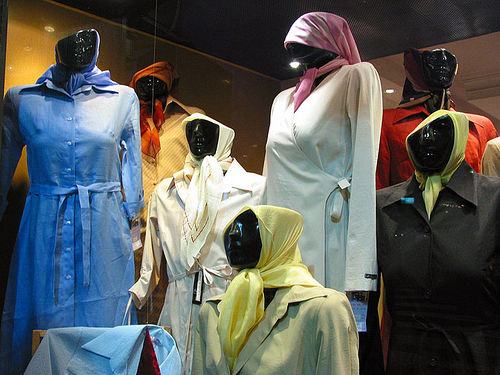Wearing the hijab
By Cassidy Herrington

Wearing the hijab
By Cassidy Herrington
When Yvonne Maffei, the blogger behind My Halal Kitchen, told Alison Cuddy about her conversion to Islam, her story resounded deeply with me. As Yvonne recalled her first steps as a Muslim, she mentioned her early experiences wearing the hijab head covering, and her eagerness to answer questions about Islam.
“I felt for my own sake … instead of having people look at me and wonder and glare, and think things that are not true, I’d rather be an open book and say, ‘Ask me anything,’ because I’m happy to tell you what’s true,” she said.
I had some small idea of what she had gone through. I didn’t convert like she did. But back in college, I wore the hijab for a month for a newspaper column. I wanted to show that conversations about Islam are missing very crucial voices — Muslims.
At the time, I was the opinions editor for my university’s newspaper, The Kentucky Kernel. It was a one-semester gig, and it often felt like an awkward flirtation. I’d been conditioned to keep my opinions out of my reporting, so I usually stuck to safer, apolitical topics like the plight of bike commuters or how to react to an awkward pause in conversation.
But my time on the opinions desk alerted me to what I consider a failure in the journalism world — newspapers’ tolerance of anonymous online comments. The absence of attribution opens an avenue for racist, misogynist and hateful posts to accumulate on a story.
When I noticed deliberately hateful remarks piling up under pieces by some Muslim columnists, I snapped.
As much as I dreaded broadcasting my feelings, I thought that silence was a more severe attack on my ethics. So I decided to wear the headscarf – the most visible association that most people have of Islam – and write about the experience.
I wore the hijab everywhere in my college town from sunrise to sundown. I had to adjust my social life that month — no bars. I was wearing a symbol associated to Islam, and I needed to represent it accurately.
My experiences in the hijab echo some of Yvonne’s story. Putting on the scarf was a challenge in the beginning. I had family members discourage me from taking on the project, mostly out of fear. But I believed that it would help me bring a new perspective to the conversation on Islam.
The responses to the scarf varied. My internship supervisor asked if my ears were cold. In the health clinic waiting room, my doctor walked right past me. When I waved him over, he said with gaping eyes, “I didn’t recognize you.” A friend I had known for years talked to me for 20 minutes without mentioning the scarf, even though she stared at it during the whole conversation.
The most frightening interaction came from an e-mail with the sound of a Muslim being silenced by three gun shots, followed by the U.S. National Anthem. The sender told me it was “Just a joke.”
The only people who directly mentioned the hijab were Arab — the owner of an Egyptian restaurant and a barista at a coffee shop near school.
I was fortunate to have been working with a refugee family from Iraq at the time. I have fond memories of spending Ramadan in their home. I tutored the three daughters after school while their mother painstakingly worked in the kitchen.
When the sun went down, the mother insisted that I stay and share a meal with the family. And I mean, insisted. If I left without my stomach bursting at the seams, she would say, “Cassie, please, have another plate, you’re making me sad.” Sometimes, if I turned my head to talk to one of the children, I caught a glimpse of a spoon refilling my plate out of the corner of my eye. That deep family bond I discovered is the defining feature that I associate with Islam today. And since wearing hijab, that family has grown to an international scale. I feel like I’ve amassed hundreds of sisters. One of them, Namra, likes to joke that “you can never leave a hijabi behind.”
My hijab column ran about two years ago, but I still receive e-mails and postcards from people around the world. This has been the most insightful part of my story — I have read and heard hundreds of hijab stories.
Mariam, a student from Dubai, approached me after a speech I gave at the University of Central Missouri. She told me that she and a friend were walking on campus when two boys approached them and muttered “terrorists” as they passed by. She and her friend chose to ignore them.
But here’s how her story ended:
“A positive thing that I noticed when wearing the hijab in the States is that I felt closer to Allah and my religion than I did before,” Mariam said. “And honestly, I feel much more confident now.”
Hijab did the same for me. I feel more confident in my convictions as a journalist and human being — it’s natural to be curious about the lives of other people. When I put the hijab over my hair, I was forced to look inward. Hijab helped me clearly see what truly defines a human being — the need to make connections with other human beings.
The positive reactions I’ve received reaffirm that people want to see more interactions like this. I received a postcard last week from my friend in Dubai that said “Thank you for showing me the true meaning of journalism.” And one critic wrote that cross-cultural encounters should be “as ordinary as a cup of Folger’s Coffee in the morning.”
The story is still being written, and the global conversation continues. Now, it’s just up to the curious to ask more questions and listen to the answers.